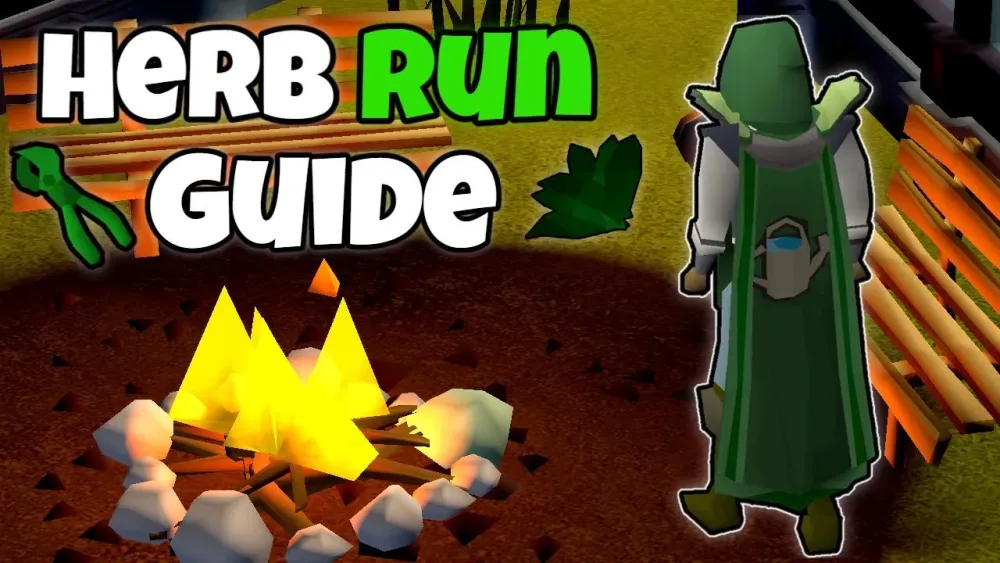Your cart is empty
Maximize Your Profits: A Guide to OSRS Herb Runs for Money Making

Herb runs in Old School RuneScape (OSRS) offer a lucrative way to generate income while engaging in a rewarding and straightforward activity. By cultivating herbs efficiently, players can maximize their profits through consistent harvesting and selling. This guide will delve into the essentials of herb runs, helping you understand the fundamental mechanics and strategies to optimize your farming efforts for greater financial gain in the game.
Herb farming in OSRS involves growing various herbs that can be harvested and sold for profit. The process begins with acquiring seeds, which can be obtained from various sources such as monster drops, shops, or as rewards from quests. Once you have your seeds, you will need to find a suitable farming patch. There are multiple herb patches located throughout Gielinor, with notable ones in places like Taverley, Ardougne, and Hosidius.
To plant your seeds, you need a spade and a Farming level that corresponds to the herb you wish to grow. Each herb has specific growth requirements, including the level needed to plant the seeds and the time it takes to grow. Generally, herbs take around 80 minutes to grow, but this can vary based on the type. It’s important to check the growth status periodically, as herbs can die if not harvested in time.
Using the right tools can significantly improve your farming efficiency. Consider using the Farming Guild, which provides additional benefits like access to more patches and the ability to grow higher-level herbs. Additionally, planting herbs in combination with using compost or supercompost can increase your yield and reduce the chances of disease, further enhancing your profit margins.
When it comes to harvesting, timing is essential. Always aim to harvest your herbs as soon as they are ready to avoid losing any crops. Once harvested, you can either sell the herbs directly on the Grand Exchange or use them for potion-making, which can also be profitable depending on market demand.
In summary, understanding the basics of herb farming in OSRS allows players to maximize their profits effectively. By selecting the right seeds, utilizing efficient farming practices, and timing your harvests, you can turn herb runs into a significant source of income in the game.
Choosing the Right Herbs for Profit

When it comes to maximizing your profits from herb runs in Old School RuneScape (OSRS), selecting the right herbs is crucial. Not all herbs are created equal, and understanding which ones yield the best returns can make a significant difference in your earnings.
Here are some key factors to consider when choosing herbs:
- Market Demand: Always keep an eye on the Grand Exchange prices. Herbs like Ranarr Weed and Snapdragon are typically in high demand due to their use in potions.
- Growth Time: Some herbs grow faster than others. For example, Guam takes only 75 minutes to grow, while Torstol takes up to 160 minutes. Faster-growing herbs mean more runs in the same time frame.
- Herb Level Requirements: Ensure you can grow the herbs you choose based on your Farming level. For example, Ranarr Weed requires level 32 Farming, so make sure you’re able to plant what you want to grow!
- Seed Cost: Weigh the cost of seeds against the potential profit. Some herbs may have high profits but also come with expensive seeds, which can cut into your overall earnings.
Based on these factors, a few herbs to consider for profit are:
| Herb | Level Required | Growth Time (minutes) | Typical Profit |
|---|---|---|---|
| Ranarr Weed | 32 | 150 | High |
| Snapdragon | 65 | 150 | Moderate to High |
| Torstol | 75 | 160 | Very High |
By carefully selecting your herbs, you can ensure that your herb runs are not only efficient but also profitable!
Optimal Routes for Herb Runs
To maximize your profit from herb runs in OSRS, knowing the best routes is essential. An efficient route minimizes travel time and maximizes the number of herbs you can collect. Here’s how to plan your herb run effectively:
1. *Start at a Farming Patch: Begin your run at the patch closest to your bank or teleport location. Common starting points include:
- Ardougne: Great if you have the Ardougne Cloak for teleportation.
- Falador: Easy access to the patch near the city.
- Taverley: Quick route with nearby teleport options.
2. Plan Your Route: Consider the locations of the farming patches. The most common patches are located in:
3. Use Teleports Wisely: Utilize teleport spells, items, or lodestones to cut down travel time. For example:
- Amulet of Glory for Karamja or Draynor Village teleports.
- Fairy Rings for instant access to multiple patches.
4. Gather Resources:* Always have a watering can or supercompost in your inventory to ensure your herbs grow to their full potential. This prep work pays off in the long run!
By following these optimal routes, you’ll be able to efficiently complete your herb runs, ensuring you maximize both time and profit. Happy farming!
5. Tools and Equipment for Efficient Herb Runs
When it comes to maximizing your herb run efficiency in Old School RuneScape (OSRS), having the right tools and equipment is crucial. Not only can the right items save you time, but they can significantly enhance your overall profit. Here’s a breakdown of what you’ll need:
- Seed Dibber: This is essential for planting your herbs. You can obtain a seed dibber easily, and it ensures that you can plant seeds quickly.
- Watering Can: Use this to keep your herbs hydrated. A filled watering can can help ensure that your plants grow to maturity without dying.
- Spade: This tool is necessary for digging up your herbs after they’ve grown. Always have one in your inventory to avoid unnecessary trips.
- Magic Secateurs: If you’ve completed the “Fairy Tale II: Cure a Queen” quest, these will increase your herb yield by 10%. Definitely worth the effort!
- Herb Sack: This is a fantastic item for storing herbs, especially if you’re doing multiple runs. It can hold up to 30 different types of herbs, making your inventory management much easier.
Additionally, consider equipping gear that enhances your Farming skills, such as:
| Item | Benefit |
|---|---|
| Farming Cape | Provides a +1 Farming bonus and allows you to teleport to the Farming Guild. |
| Greenhouse Gear | Increases yield and reduces time spent on herb runs. |
With these tools and equipment, you’ll be well-equipped to maximize your herb runs!
6. Tips for Maximizing Your Herb Run Profits
Maximizing your profits from herb runs in OSRS is all about strategy and planning. Here are some valuable tips to help you get the most out of your time and effort:
- Choose the Right Herbs: Some herbs sell for much higher prices than others. Focus on planting popular herbs like Ranarr, Snapdragon, and Torstol, which are always in demand.
- Use Herb Boxes: If you have the Lumberjack outfit, consider using herb boxes for extra profit. This method allows you to stack up herbs for future runs.
- Plan Your Route: Efficiently plan the route you take for your herb runs to minimize travel time. Use teleportation methods to get to your farming patches quickly.
- Check Prices Regularly: The market for herbs can fluctuate. Make sure to check the Grand Exchange prices frequently to know when to sell for maximum profit.
- Utilize Farming Contracts: Completing contracts can provide you with extra seeds, and you can earn rewards that can further enhance your herb runs.
By incorporating these tips into your herb run strategy, you’ll not only save time but also see a significant boost in your profits. Happy farming!
7. Common Mistakes to Avoid in Herb Farming
When diving into the world of herb farming in Old School RuneScape (OSRS), it’s essential to be aware of common pitfalls that can hinder your profit-making potential. Here are some mistakes to steer clear of:
- Neglecting to Use the Right Tools: Always have a spade and your preferred herb seeds ready. Forgetting these can waste precious time.
- Ignoring the Growth Times: Not knowing how long your herbs take to grow can lead to missed opportunities. Keep track of the growth cycle!
- Failing to Check the Market: Prices fluctuate often. Always check the Grand Exchange for current herb prices before selling your harvest.
- Not Using Compost: Compost increases the yield of your herbs. Skipping this step can cost you potential profits.
- Overlooking Farming Levels: Make sure you’re planting herbs that match your farming level. Planting too high-level herbs can lead to wasted seeds.
- Ignoring Pest Control: Weeds can ruin your crop. Regularly check and remove them to ensure a bountiful harvest.
- Not Planning Your Runs: Create a schedule that maximizes your time. Efficient routes and timing can drastically improve your profit.
Avoiding these mistakes can significantly enhance your herb farming experience and boost your profits. Remember, preparation and knowledge are key!
8. Conclusion: Making the Most of Your Herb Runs
In conclusion, maximizing your profits through herb runs in OSRS requires a blend of strategy, knowledge, and efficient practices. By following the tips outlined in this guide, you can harness the full potential of herb farming. Here’s a quick recap:
| Tip | Benefit |
|---|---|
| Use Compost | Increases yield per harvest |
| Plan Efficient Routes | Saves time and maximizes profit |
| Monitor Market Prices | Ensures you sell at the right time |
| Regularly Check for Weeds | Protects your crops and increases yield |
By avoiding common mistakes and implementing these strategies, you’ll find yourself reaping the rewards of your labor in no time. Happy farming, and may your herb runs be both fruitful and profitable!
